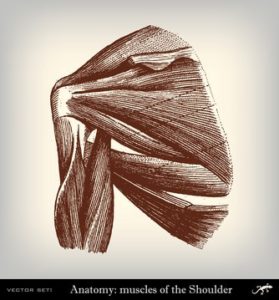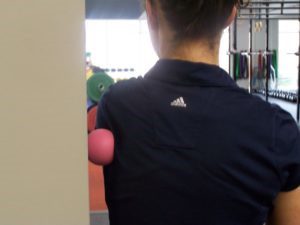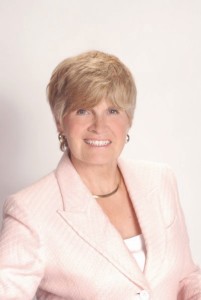Regain Your Full Range Of Motion
Author: Julie Donnelly, LMT – The Pain Relief Expert
Editor: Dr. Steve Chaney
 Recently I’ve had a client coming to me for frozen shoulder pain treatment. “Mary” is suffering from “Frozen Shoulder.” It doesn’t sound so bad, but don’t let the simple diagnosis hide the fact that this condition causes more than just pain. Mary’s shoulder joint was so frozen that she had minimal range-of-motion in any direction, and sleeping was a nightmare! Regardless of which way she slept – on her back or side, the ache would wake her up several times a night, often in tears from the pain.
Recently I’ve had a client coming to me for frozen shoulder pain treatment. “Mary” is suffering from “Frozen Shoulder.” It doesn’t sound so bad, but don’t let the simple diagnosis hide the fact that this condition causes more than just pain. Mary’s shoulder joint was so frozen that she had minimal range-of-motion in any direction, and sleeping was a nightmare! Regardless of which way she slept – on her back or side, the ache would wake her up several times a night, often in tears from the pain.
Physical therapy wasn’t helping at all. Her frozen shoulder kept getting worse, and the only relief she had from the pain was by taking strong pain-killing drugs. The all-too-real fear of opioid addiction caused her to only take the drugs when the pain was unbearable. She is a hairstylist so this situation was having a very negative effect on her income and future. On a more personal note, it certainly wasn’t helping her intimate relationship with her husband. She was getting frantic for a solution.
Fortunately, the client of a co-worker had come to my office when she was in pain, and she gave Mary my card. That was the beginning of a long journey, but one that is helping her more than she’d ever imagined possible.
What Causes A Frozen Shoulder?
 Your shoulder has more muscle attachments than any other joint in your body. Several muscles don’t attach right into your shoulder joint, but as they pull on your arm or shoulder blade, your shoulder moves. This is the reason that your shoulder and arm can move in so many directions. More than 15 muscles need to all work together to enable you to have a full range-of-motion with your shoulder and arms.
Your shoulder has more muscle attachments than any other joint in your body. Several muscles don’t attach right into your shoulder joint, but as they pull on your arm or shoulder blade, your shoulder moves. This is the reason that your shoulder and arm can move in so many directions. More than 15 muscles need to all work together to enable you to have a full range-of-motion with your shoulder and arms.
Frozen shoulder is caused by several, or many, of these muscles all being held taut because of multiple spasms. When one muscle contracts, another must lengthen to allow for the contraction.
For example, when you are swimming and the muscles of your chest are pulling your shoulders/arms forward, the muscles of your back need to lengthen. And, when you want to reach back to take a tennis swing, the muscles of your chest must lengthen. Or, when you want to lift your arm up to reach the top of your closet, the muscles that bring your arm down must lengthen. But, when you reach down to pick something up from the floor, the muscles on top of your shoulder must lengthen. It’s always a matter of opposing muscles both needing to do their part in order for you to move your shoulder and arm.
Frozen Shoulder Pain Treatment
 Actually, there are too many treatments for me to cover in detail in this short article. If you have been receiving Health Tips from the Professor for some time, you have many of my treatments from previous blogs.
Actually, there are too many treatments for me to cover in detail in this short article. If you have been receiving Health Tips from the Professor for some time, you have many of my treatments from previous blogs.
Basically, if you have stiffness in your shoulder, you need to look at the movements you can’t make. Next, think about the opposing muscle that needs to be lengthened in order to make that movement. This is the muscle that needs to be treated to start to release your frozen shoulder.
One treatment you can do is for your infraspinatus muscle. This is the muscle that pulls your arm back.
Put a ball on the belly of the muscle, which is at the center of your shoulder blade, and apply pressure. Hold the pressure for about a minute, release for 5 seconds, and repeat. Do this several times and then stretch that muscle.
To help people eliminate pain and stretch safely, I created a program called Focus Flexibility Training. This DVD program shows you how to treat all of the muscles of your shoulder and a whole lot more.
When it comes to Frozen Shoulder pain treatment, you’ll ultimately need to treat most, if not all of your shoulder muscles. It’s not a fast treatment, but it does work.
Wishing you well,
Julie Donnelly
About The Author
 Julie Donnelly is a Deep Muscle Massage Therapist with 20 years of experience specializing in the treatment of chronic joint pain and sports injuries. She has worked extensively with elite athletes and patients who have been unsuccessful at finding relief through the more conventional therapies.
Julie Donnelly is a Deep Muscle Massage Therapist with 20 years of experience specializing in the treatment of chronic joint pain and sports injuries. She has worked extensively with elite athletes and patients who have been unsuccessful at finding relief through the more conventional therapies.
She has been widely published, both on – and off – line, in magazines, newsletters, and newspapers around the country. She is also often chosen to speak at national conventions, medical schools, and health facilities nationwide.
These statements have not been evaluated by the Food and Drug Administration. This information is not intended to diagnose, treat, cure or prevent any disease.
